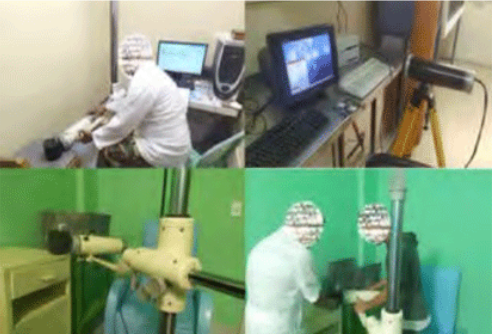Results of the national intercomparison exercise in internal dosimetry
Main Article Content
Abstract
The manipulation of unsealed sources of radiation for diagnostic and therapeutic purposes in the practice of nuclear medicine in Cuba represents a risk, from a radiological point of view, for occupationally exposed personnel linked to this activity. For this reason, the existence of a surveillance program that verifies that said risk is minimized, based on compliance with existing national regulations and observance of international recommendations, is essential. The basis of this program is the performance of an individual monitoring that allows to quantify the activity of the radionuclide incorporated by the exposed personnel, with the final objective of estimating its committed effective dose. In the case of Cuba, 131I is the radionuclide that poses the greatest risk from the point of view of incorporation, for which special attention has been devoted to it.
Since 2011, the Internal Dosimetry Laboratory of the Center for Radiation Protection and Hygiene has developed various projects that include training, calibration of equipment in hospital institutions, risk assessment of incorporation at the national level and development of a radiological surveillance guide as basis for implementing the programs. The summit of all these efforts and the most effective way to verify its usefulness was the performance of an Intercomparison Exercise on Measured Thyroid Activity and Committed Effective Dose due to the Incorporation of 131I in the Nuclear Medicine Departments of the country. Three of the main institutions in which the aforementioned radionuclide is used participated in the exercise. The results obtained were satisfactory, demonstrating the existing progress on the subject and pointing out the areas where it is necessary to focus efforts to correct deficiencies.
Article Details

This work is licensed under a Creative Commons Attribution-NonCommercial 4.0 International License.
Aquellos autores/as que tengan publicaciones con esta revista, aceptan los términos siguientes:
- Los autores/as conservarán sus derechos de autor y garantizarán a la revista el derecho de primera publicación de su obra, el cuál estará simultáneamente sujeto a la Licencia Creative Commons Attribution-NonCommercial 4.0 International (CC BY-NC 4.0) que permite a terceros compartir la obra siempre que se indique su autor y su primera publicación esta revista. Bajo esta licencia el autor será libre de:
- Compartir — copiar y redistribuir el material en cualquier medio o formato
- Adaptar — remezclar, transformar y crear a partir del material
- El licenciador no puede revocar estas libertades mientras cumpla con los términos de la licencia
Bajo las siguientes condiciones:
- Reconocimiento — Debe reconocer adecuadamente la autoría, proporcionar un enlace a la licencia e indicar si se han realizado cambios. Puede hacerlo de cualquier manera razonable, pero no de una manera que sugiera que tiene el apoyo del licenciador o lo recibe por el uso que hace.
- NoComercial — No puede utilizar el material para una finalidad comercial.
- No hay restricciones adicionales — No puede aplicar términos legales o medidas tecnológicas que legalmente restrinjan realizar aquello que la licencia permite.
- Los autores/as podrán adoptar otros acuerdos de licencia no exclusiva de distribución de la versión de la obra publicada (p. ej.: depositarla en un archivo telemático institucional o publicarla en un volumen monográfico) siempre que se indique la publicación inicial en esta revista.
- Se permite y recomienda a los autores/as difundir su obra a través de Internet (p. ej.: en archivos telemáticos institucionales o en su página web) antes y durante el proceso de envío, lo cual puede producir intercambios interesantes y aumentar las citas de la obra publicada. (Véase El efecto del acceso abierto).
La Revista Nucleus solo aceptará contribuciones que no hayan sido previamente publicados y/o procesados, por otra publicación. Cualquier violación ese sentido será considerada una falta grave por parte del autor principal lo cual será objeto valoración por parte del Consejo Editorial, el cual dictaminará al respecto.
References
[2]. Organismo Internacional de Energía Atómica (OIEA). Protección radiológica y seguridad de las fuentes de radiación: normas básicas internacionales de seguridad. STI/PUB/1578. Viena: OIEA, 2016. ISBN 978-92-0-307915-0.
[3]. CITMA. Guía de seguridad para la práctica de Medicina Nuclear. Resolución Nro. 40/2011 del CITMA. La Habana: CITMA, 2012.
[4]. CASTELLANI C, MARSH J, et. al. EURADOS-IDEAS Guidelines (version 2) for the estimation of committed doses from incorporation monitoring data. Radiation Protection Dosimetry. 2016; 170(1-4): 17-20.
[5]. Proyecto ARCAL Procedimiento para determinación in vivo de radionucleidos en el cuerpo humano. Código: PR/ARCAL LXXVIII/04. 2005.
[6]. International Commission on Radiological Protection. Individual monitoring for internal exposure of workers. ICRP Publication 78. Annals of the ICRP (1998).
[7]. International Commission on Radiological Protection (ICRP). Dose coefficients for intakes of radionuclides by workers. ICRP Publication 68. Ann. ICRP 24 (4).

